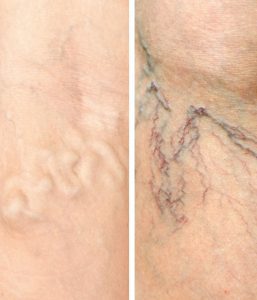

Several patients who suffer from varicose veins often complain of a cramping or aching sensation near the veins. Other typical symptoms include fatigue, itching, throbbing, cramping, burning, and tingling.
Varicose veins, however, shouldn’t be confused with spider veins. Spider veins are the much earlier, gentler version of varicose veins. They’re best described as tiny, blue, red, or purple vessels near the surface of the skin. Like varicose veins, spider veins also twist and turn, but they don’t bulge or swell. Generally, spider veins aren’t painful, and they are not associated with blood clots.
While it’s possible to have both spider and varicose veins, it’s not necessarily true that spider veins will indefinitely lead to varicose veins. However, having varicose veins and spider veins indicates the presence of underlying vein disease, also known as chronic venous insufficiency.
How Varicose and Spider Veins Develop
Varicose and spider veins develop naturally when blood flow issues are present. A healthy vein will carry blood to the heart through valves that allow blood to flow in only one direction keeping the blood moving through the right pathways and preventing backflow. These healthy veins do their job by effectively delivering blood from superficial veins to deeper ones that eventually lead to the heart.
However, when veins don’t function properly, it can cause blood to collect inside your veins. When this happens, the blood pushes up against the walls within your vein, creating pressure weakening the vessel wall.
Ultimately, this pressure is what causes veins to twist and bulge.
Depending on how large the vein is and how swollen it gets, it will result in spider veins or varicose veins.
Treatment Options for Vein Disease
If you’re eager to rid your legs of varicose and spider veins and regain your quality of life, there are several proven medical treatments for you to consider.
Polidocanol Injectable Foam (Varithena®)
is a minimally invasive, nonsurgical treatment doesn’t require incisions. The injection site is usually numbed, but no additional anesthesia is required. A catheter is inserted into the malfunctioning vein or sometimes a direct injection is used. The foam fills up the targeted part of the vein, and the diseased vein collapses. (For smaller branches with vein reflux, foam is injected directly into the vein to eliminate it.) Blood flow shifts to healthier veins nearby.
The VenaSeal™ Closure System uses an advanced medical adhesive to close and seal varicose veins. VenaSeal™ treatment minimizes patient discomfort and reduces recovery time, making it a good choice for many people. It’s the only procedure approved for use in the United States that doesn’t use heat, tumescent local anesthesia, or a sclerosant. Instead, VenaSeal™ uses a medical grade “glue” to shut down diseased veins.
Thermal Ablation, with this procedure, a small catheter is placed into the problematic vein, usually longer and larger veins. This catheter delivers radiofrequency into the vein wall, causing it to grow hot, collapse and close. It is an outpatient procedure that requires the administration of local anesthesia.
Ultimately, remember that vein disease is progressive and will get worse without treatment, so when you see signs of it, seek treatment.
Florida Lakes Vein Center offers convenient appointments in our Lakewood Ranch office Tuesday – Thursday 8a.m. – 5p.m. and Friday 8a.m. – 3p.m. Call 941.866.8989 to schedule your free vein screening.
Florida Lakes Vein Center
FloridaLakesVeinCenter.com
941-777-7771
19790 Wellen Park Blvd., Ste 201B
Venice, FL 34293
941-257-0765
1217 Jacaranda Blvd.,
Venice, FL 34292
941-866-8989
9114 Town Center Pkwy, Ste 101,
Lakewood Ranch, FL 34202
Dr. Phillips & Dr. Lackey
 Southwest Florida's Health and Wellness Magazine Health and Wellness Articles
Southwest Florida's Health and Wellness Magazine Health and Wellness Articles

